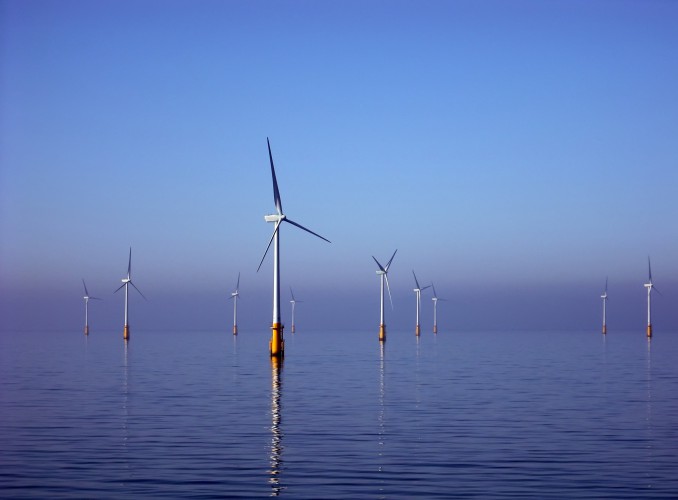
The Cooper administration announced Wednesday another step toward developing a clean energy economy.
Gov. Roy Cooper’s office said his newest directive, executive order No. 218, signed Wednesday reaffirms the state’s commitment to creating clean energy jobs, increasing economic opportunities and reducing greenhouse gas emissions through the expansion of offshore wind power.
Supporter Spotlight
“Offshore wind power will help North Carolina create jobs and generate economic development while helping us transition to a clean energy economy,” Cooper said in a statement. “North Carolina’s national leadership in clean energy and manufacturing plus our highly trained workforce create a strong business environment for offshore wind supply chain and manufacturing companies.”
The order calls for actions to secure jobs and economic development associated with the industry’s estimated investment of $140 billion in projects over the next 15 years. The order also sets offshore wind development goals of 2.8 gigawatts off the state’s coast by 2030 and 8.0 gigawatts by 2040. The administration said that the goals will enable the state to use wind to power roughly 2.3 million homes by 2040.
Officials said the development of offshore wind also will help achieve goals set in the October 2019 North Carolina Clean Energy Plan, a part of Executive Order 80: North Carolina’s Commitment to Address Climate Change and Transition to a Clean Energy Economy signed in October 2018. The clean energy plan sets a plan for a 70% reduction in power sector greenhouse gas emissions by 2030 and carbon neutrality by 2050.
“This coordinated approach to developing our offshore wind supply chain will bring new jobs to North Carolina for generations to come,” said North Carolina Commerce Secretary Machelle Baker Sanders in a statement. “From building out the supply chain, to installing equipment, to operating the wind facilities, North Carolina’s manufacturers and workforce are well positioned to play an integral role in the entire East Coast market, not just for projects directly off the state’s coast.”
The latest executive order directs the state Department of Commerce to name a clean energy economic development coordinator and establish the North Carolina Taskforce for Offshore Wind Economic Resource Strategies, or NC TOWERS.
Supporter Spotlight
The new order also directs the North Carolina Department of Environmental Quality and the North Carolina Department of Military and Veterans Affairs to designate offshore wind coordinators and take steps to support offshore wind. The order directs quarterly meetings of the North Carolina Offshore Wind Interagency Workgroup to ensure offshore wind activities are well coordinated among leadership in relevant agencies.
The North Carolina Department of Military Veterans Affairs committed to collaborating with Cooper, state agencies, local officials and the Department of Defense to find solutions that enable offshore wind development “while preserving our state’s military installation’s ability to conduct testing, training, and operations critical to our military readiness,” Department of Military Veterans Affairs Secretary, retired Lt. Gen. Walter E. Gaskin, said. “We support this effort and look forward to continued coordination to help North Carolina meet its renewable energy goals while maintaining our military readiness and ensuring our national security.”
Rep. Greg Murphy, R-N.C., told Coastal Review that to combat the rising costs of power in North Carolina, we need an all-of-the-above approach to energy independence, which includes wind power.
“However, with so many threats from foreign enemies, we must have a military that is fully trained and ready. I urge Governor Cooper work closely with the Department of Defense to ensure the construction of an offshore wind power system will not interfere with our military’s capabilities of readiness,” he said.
The order follows a bipartisan memorandum of understanding among the governors of North Carolina, Maryland and Virginia in October 2020 that created the Southeast and Mid-Atlantic Regional Transformative Partnership for Offshore Wind Energy Resources, or SMART-POWER. The SMART-POWER memorandum of understanding provides a framework for the three states to cooperatively promote, develop and expand offshore wind energy and the accompanying industry supply chain and workforce.
“The coordinated effort of state and federal partners on this issue is an important step forward in our transition to a clean energy economy in North Carolina and key to meeting the goals of the state’s Clean Energy Plan,” said North Carolina Clean Energy Director Dionne Delli-Gatti.
The governor’s announcement “signals that the state isn’t watching from the sidelines when it comes to offshore wind, ” said Michelle Allen, project manager for Environmental Defense Fund’s North Carolina Political Affairs team, in a statement.
“The joint effort, spanning the Department of Commerce, Department of Environmental Quality, and the Department of Military and Veterans Affairs, demonstrates the broad consensus around benefits that offshore wind, and its manufacturing base, will bring to North Carolina workers and communities,” she said. “The bold targets set by this order and the creation of the Offshore Wind Interagency Workgroup underscores the state’s commitment to leading on offshore wind and puts the state in a strong position to compete for as much of the burgeoning $140 billion industry as possible.”
National Ocean Industries Association president Erik Milito told Coastal Review that Cooper’s advocacy for wind development offshore North Carolina is great news for the state.
“North Carolina is capitalizing on a generational energy and economic opportunity. However, North Carolina needs help from Washington, D.C., to meet Governor Cooper’s goals. North Carolina’s leaders should continue to push Congress and President Biden to find a solution that will undo the offshore energy leasing moratorium that begins in July 2022,” he said. “Ensuring future lease sales offshore North Carolina and other southern states will be fundamental in meeting Governor Coopers’ offshore wind goals.”
The National Ocean Industries Association commissioned Wood Mackenzie to conduct a study on potential offshore wind lease sales that shows lease sales could support 37,200 jobs supported annually, $3 billion in annual wages, $233 million in annual state tax creation and $44.9 billion in total capital investment, according to the association.
The North Carolina Department of Commerce released in March an offshore wind supply chain and infrastructure report that looks at the state’s opportunities to address the offshore wind industry’s supply chain and manufacturing needs.
The report by BVG Associates, a consulting company with wind energy experience, and N.C. State’s Clean Energy Technology Center, forecasts East Coast offshore capacity to exceed 40 gigawatts by 2035. The state could benefit from a more than $100 billion market opportunity, officials said previously.







